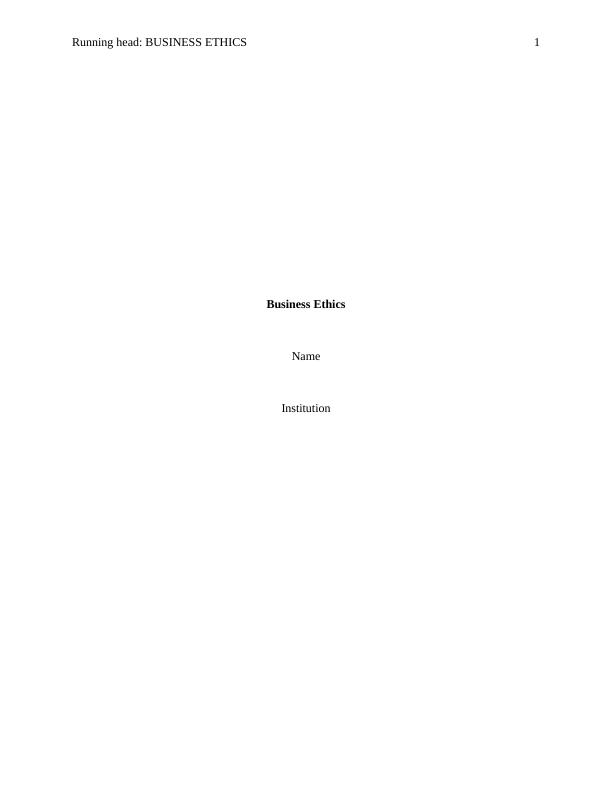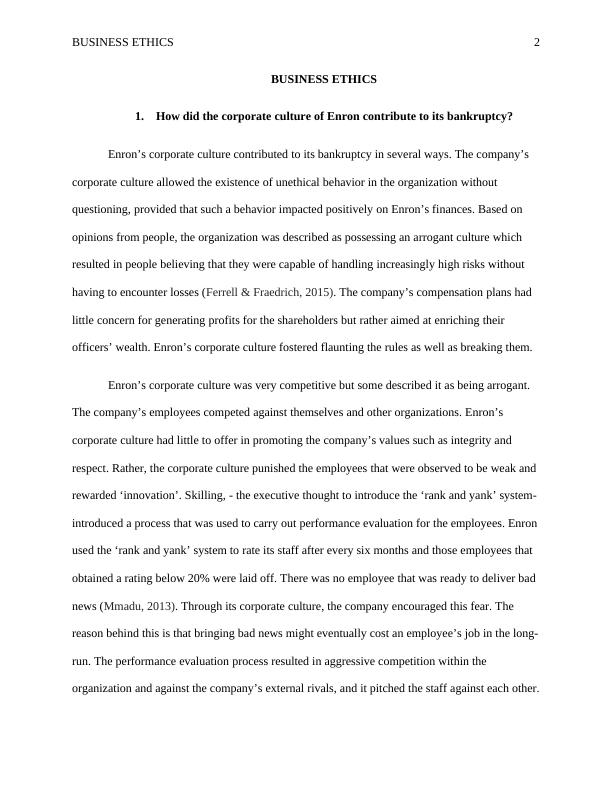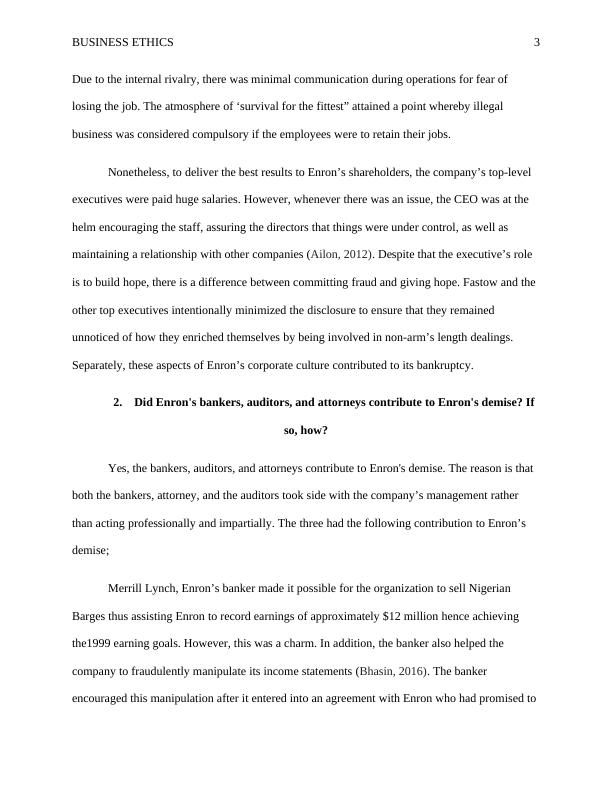How Enron's Corporate Culture Led to Bankruptcy
8 Pages2019 Words42 Views
Added on 2023-01-24
About This Document
This article explores how Enron's corporate culture allowed for unethical behavior and contributed to its bankruptcy. It also examines the role of Enron's bankers, auditors, and attorneys in its downfall.
How Enron's Corporate Culture Led to Bankruptcy
Added on 2023-01-24
ShareRelated Documents
Running head: BUSINESS ETHICS 1
Business Ethics
Name
Institution
Business Ethics
Name
Institution

BUSINESS ETHICS 2
BUSINESS ETHICS
1. How did the corporate culture of Enron contribute to its bankruptcy?
Enron’s corporate culture contributed to its bankruptcy in several ways. The company’s
corporate culture allowed the existence of unethical behavior in the organization without
questioning, provided that such a behavior impacted positively on Enron’s finances. Based on
opinions from people, the organization was described as possessing an arrogant culture which
resulted in people believing that they were capable of handling increasingly high risks without
having to encounter losses (Ferrell & Fraedrich, 2015). The company’s compensation plans had
little concern for generating profits for the shareholders but rather aimed at enriching their
officers’ wealth. Enron’s corporate culture fostered flaunting the rules as well as breaking them.
Enron’s corporate culture was very competitive but some described it as being arrogant.
The company’s employees competed against themselves and other organizations. Enron’s
corporate culture had little to offer in promoting the company’s values such as integrity and
respect. Rather, the corporate culture punished the employees that were observed to be weak and
rewarded ‘innovation’. Skilling, - the executive thought to introduce the ‘rank and yank’ system-
introduced a process that was used to carry out performance evaluation for the employees. Enron
used the ‘rank and yank’ system to rate its staff after every six months and those employees that
obtained a rating below 20% were laid off. There was no employee that was ready to deliver bad
news (Mmadu, 2013). Through its corporate culture, the company encouraged this fear. The
reason behind this is that bringing bad news might eventually cost an employee’s job in the long-
run. The performance evaluation process resulted in aggressive competition within the
organization and against the company’s external rivals, and it pitched the staff against each other.
BUSINESS ETHICS
1. How did the corporate culture of Enron contribute to its bankruptcy?
Enron’s corporate culture contributed to its bankruptcy in several ways. The company’s
corporate culture allowed the existence of unethical behavior in the organization without
questioning, provided that such a behavior impacted positively on Enron’s finances. Based on
opinions from people, the organization was described as possessing an arrogant culture which
resulted in people believing that they were capable of handling increasingly high risks without
having to encounter losses (Ferrell & Fraedrich, 2015). The company’s compensation plans had
little concern for generating profits for the shareholders but rather aimed at enriching their
officers’ wealth. Enron’s corporate culture fostered flaunting the rules as well as breaking them.
Enron’s corporate culture was very competitive but some described it as being arrogant.
The company’s employees competed against themselves and other organizations. Enron’s
corporate culture had little to offer in promoting the company’s values such as integrity and
respect. Rather, the corporate culture punished the employees that were observed to be weak and
rewarded ‘innovation’. Skilling, - the executive thought to introduce the ‘rank and yank’ system-
introduced a process that was used to carry out performance evaluation for the employees. Enron
used the ‘rank and yank’ system to rate its staff after every six months and those employees that
obtained a rating below 20% were laid off. There was no employee that was ready to deliver bad
news (Mmadu, 2013). Through its corporate culture, the company encouraged this fear. The
reason behind this is that bringing bad news might eventually cost an employee’s job in the long-
run. The performance evaluation process resulted in aggressive competition within the
organization and against the company’s external rivals, and it pitched the staff against each other.

BUSINESS ETHICS 3
Due to the internal rivalry, there was minimal communication during operations for fear of
losing the job. The atmosphere of ‘survival for the fittest” attained a point whereby illegal
business was considered compulsory if the employees were to retain their jobs.
Nonetheless, to deliver the best results to Enron’s shareholders, the company’s top-level
executives were paid huge salaries. However, whenever there was an issue, the CEO was at the
helm encouraging the staff, assuring the directors that things were under control, as well as
maintaining a relationship with other companies (Ailon, 2012). Despite that the executive’s role
is to build hope, there is a difference between committing fraud and giving hope. Fastow and the
other top executives intentionally minimized the disclosure to ensure that they remained
unnoticed of how they enriched themselves by being involved in non-arm’s length dealings.
Separately, these aspects of Enron’s corporate culture contributed to its bankruptcy.
2. Did Enron's bankers, auditors, and attorneys contribute to Enron's demise? If
so, how?
Yes, the bankers, auditors, and attorneys contribute to Enron's demise. The reason is that
both the bankers, attorney, and the auditors took side with the company’s management rather
than acting professionally and impartially. The three had the following contribution to Enron’s
demise;
Merrill Lynch, Enron’s banker made it possible for the organization to sell Nigerian
Barges thus assisting Enron to record earnings of approximately $12 million hence achieving
the1999 earning goals. However, this was a charm. In addition, the banker also helped the
company to fraudulently manipulate its income statements (Bhasin, 2016). The banker
encouraged this manipulation after it entered into an agreement with Enron who had promised to
Due to the internal rivalry, there was minimal communication during operations for fear of
losing the job. The atmosphere of ‘survival for the fittest” attained a point whereby illegal
business was considered compulsory if the employees were to retain their jobs.
Nonetheless, to deliver the best results to Enron’s shareholders, the company’s top-level
executives were paid huge salaries. However, whenever there was an issue, the CEO was at the
helm encouraging the staff, assuring the directors that things were under control, as well as
maintaining a relationship with other companies (Ailon, 2012). Despite that the executive’s role
is to build hope, there is a difference between committing fraud and giving hope. Fastow and the
other top executives intentionally minimized the disclosure to ensure that they remained
unnoticed of how they enriched themselves by being involved in non-arm’s length dealings.
Separately, these aspects of Enron’s corporate culture contributed to its bankruptcy.
2. Did Enron's bankers, auditors, and attorneys contribute to Enron's demise? If
so, how?
Yes, the bankers, auditors, and attorneys contribute to Enron's demise. The reason is that
both the bankers, attorney, and the auditors took side with the company’s management rather
than acting professionally and impartially. The three had the following contribution to Enron’s
demise;
Merrill Lynch, Enron’s banker made it possible for the organization to sell Nigerian
Barges thus assisting Enron to record earnings of approximately $12 million hence achieving
the1999 earning goals. However, this was a charm. In addition, the banker also helped the
company to fraudulently manipulate its income statements (Bhasin, 2016). The banker
encouraged this manipulation after it entered into an agreement with Enron who had promised to

End of preview
Want to access all the pages? Upload your documents or become a member.
Related Documents
Enron: Questionable Accounting Leads to Collapselg...
|6
|1288
|172
